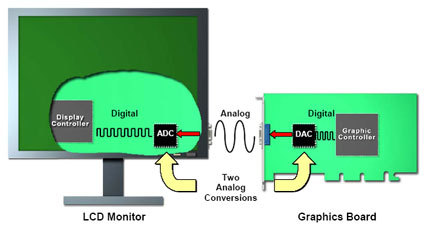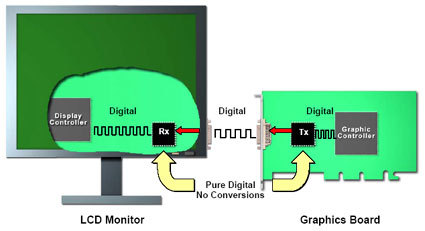The TFT Connection: Do NVIDIA and ATi Deliver?
The Monitor Connection
Classical CRT monitors are analog devices and, as such, the electron cannon that emits the electron beam - which in turn draws the image on the screen - requires analog input signals. In principle, a CRT monitor works just like any classical television set.
It is the graphics card's job to generate these analog signals. A DAC (digital-to-analog converter) converts the digital (parallel) information provided by the graphics chip into analog signals, which are then sent to the monitor through the VGA connector. On older graphics cards, the DAC, usually referred to as the RAMDAC in the case of graphics cards, used to be a separate chip found on the circuit board. Nowadays, two RAMDACs are usually integrated with the graphics processor, one for each monitor output.
However, the requirements changed with the advent of TFT or flat-panel monitors. This new generation of displays requires digital signal input to be able to display an image. The trouble was that at the time of their introduction, 100% of all available consumer graphics cards used the tried-and-true (analog) VGA connector. The quick-and-dirty solution was to take the analog signal furnished by the graphics card and to simply re-convert it to a digital signal in the TFT monitor, using an ADC (analog-to-digital converter). Obviously, this approach resulted in reduced signal quality.
Connecting a TFT monitor via VGA means sub-par performance. The graphics processor provides digital data, which is then converted into an analog signal, transferred to the monitor and converted back into digital for the processor. The result is an unnecessary loss of signal quality.
If the signal leaves the graphics card in digital form and the display accepts a digital input signal, it would only seem sensible to transfer the data digitally. Nonetheless, it took quite a while before a standard for digital signal data transfer became accepted. Several standards, suggested by a number of working groups, failed to gain a foothold in the market and consequently quickly vanished. After this, Fujitsu, Compaq, HP, IBM, Intel, NEC and Silicon Image founded the DDWG (Digital Display Work Group) in 1998. In April 1999, this group announced the DVI Standard 1.0, which has since become the accepted standard for digital monitor connections and digital displays.
The only sensible way: All digital, all the way. This is what DVI (and several other standards before it) was designed for.
Get Tom's Hardware's best news and in-depth reviews, straight to your inbox.
-
Thanks for this. Saved me lots of trouble with (not) chosing an incompatible DVI cable for my monitor / computer connection.Reply

